How to Become a Strawberry Plant Whisperer or What Are My Strawberry Plant’s Leaves Telling Me?

Are your strawberry plants talking to you? Yes! Strawberry leaves can tell you a lot about the health of the plants and how many berries you are likely to get from them.
Often when we search the internet to learn what different colors on strawberry leaves mean, it seems we have to already know what the problem is. Here you can find the leaf signs and their meanings, not the other way around.
Undersides of leaves
Watery lesions on the back of strawberry leaves are a result of angular leaf spot caused by the bacteria Xanthomonas fragariae. The bacteria is hiding in your plant’s vascular system and oozing out of these lesions. It spreads in wet or humid conditions and enters wounds or natural openings on nearby plants.
If you notice an infected plant at this stage, separate it from healthy plants in dry conditions. You can try treating the plant with an antibiotic called validamycin. For home growers, the best solution is to remove the plant at the end of the season and let the bacteria left in the soil die over winter. Angular leaf spot alone doesn’t have too much impact on berry production.
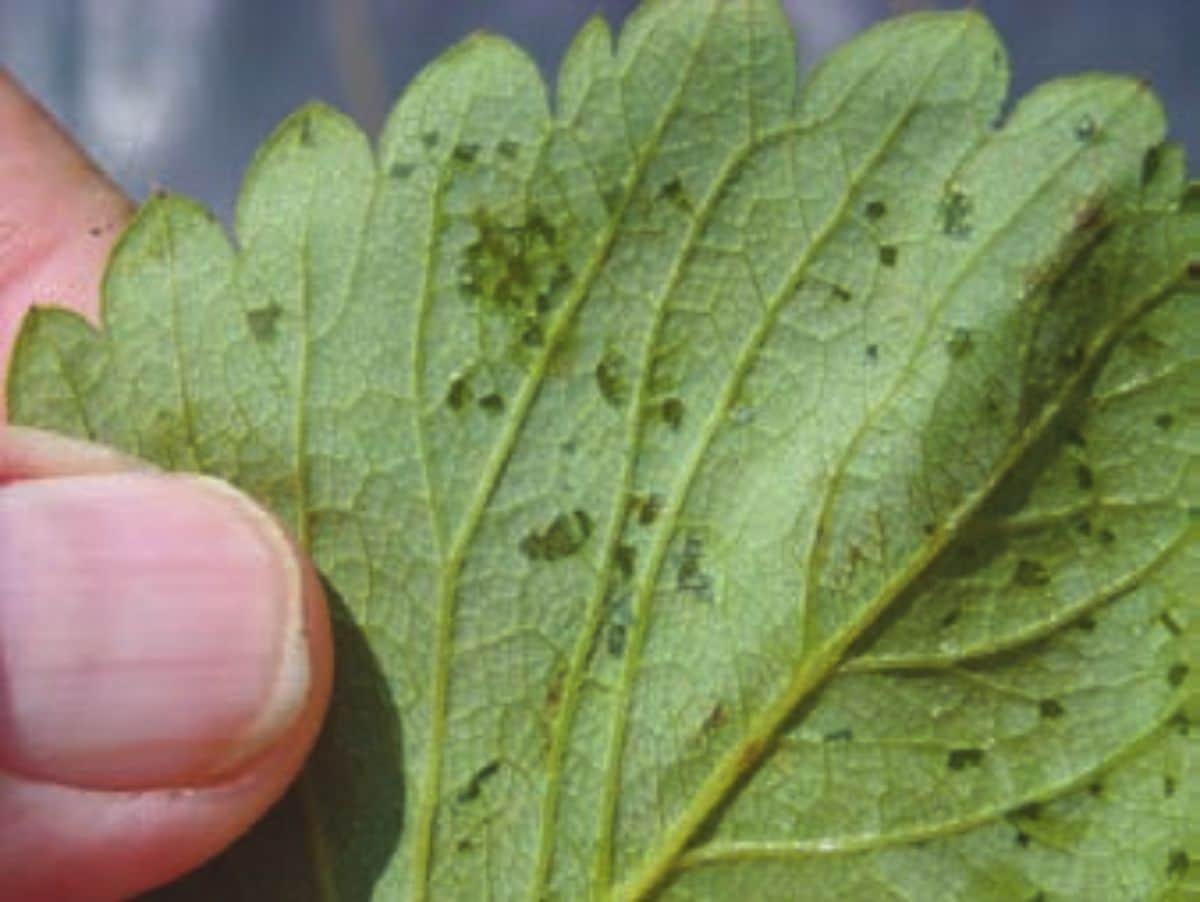
Photo by Michael A. Ellis as found on Ohioline.edu
White fluffy patches
White fluffy patches on leaves are powdery mildew. Powdery mildew attacks young leaves, flowers, and fruit. Spray your plants once a week with a mixture of 1 part milk to 2 parts water. The milk kills the fungus while nourishing the plant, and won’t harm beneficial bugs.
Powdery mildew will survive in the soil over winter so consider treating the whole bed with potassium bicarbonate to prevent future problems.
Red
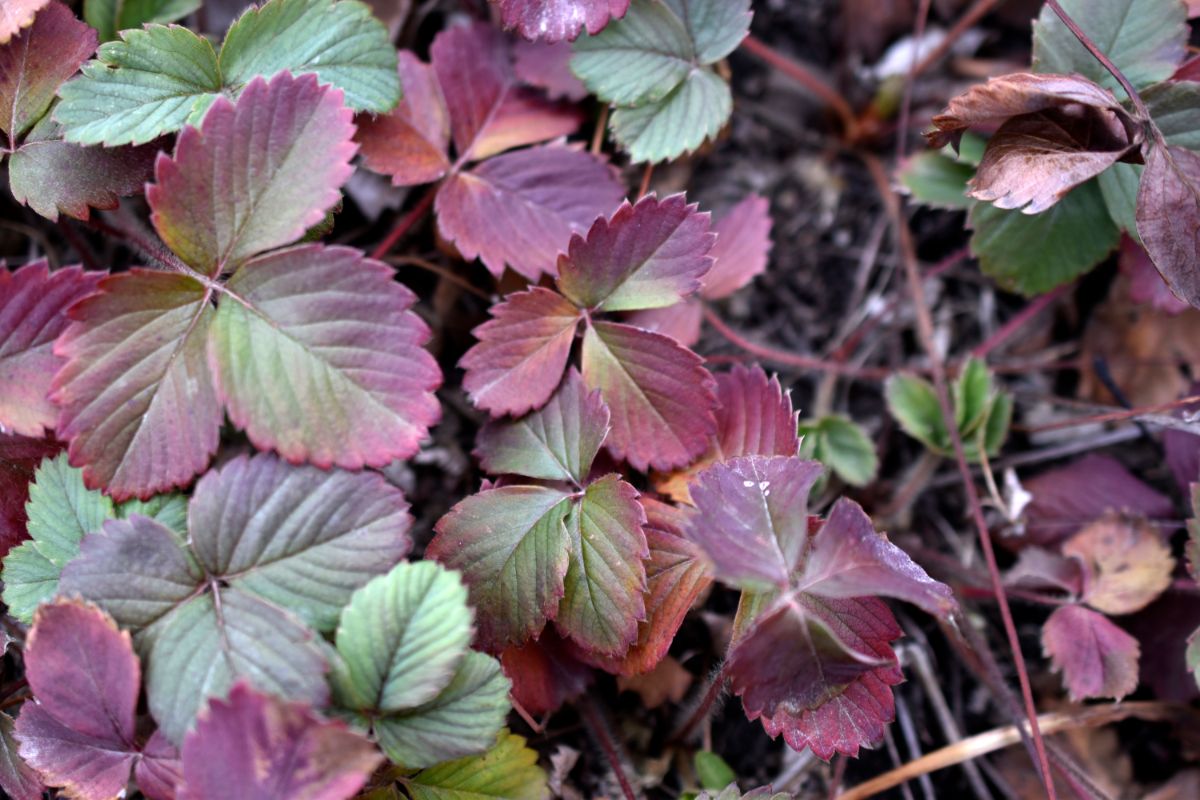
Old leaves
Is it the end of the season? Are temperatures dropping a little early? Red strawberry leaves could simply be showing you that the season is changing. They should come back in spring green and happy. If not, check into these other possibilities.
Red-orange field with small purple spots
If your strawberry leaves are turning bright red-orange and have small solid purple spots, they have leaf scorch. Eventually, the edges will turn brown and dry, appearing scorched. Remove the infected leaves and weeds to increase airflow.
Yellow
Overwatering
Strawberry plants need about 1 inch of water a day. If your strawberry leaves are turning yellow, check the moisture just below the surface of the soil. If the soil is very wet just before watering, skip watering until the soil is only damp just below the surface.
Keep checking the soil around your plants to determine when to water again. The yellow leaves will return to green as the moisture level balances out.
Green veins on yellow background
If the leaves turn a uniform yellow-green but the leaves remain dark green, often the problem is an iron deficiency. This is more common in hydroponic gardens. Try a foliar fertilizer.
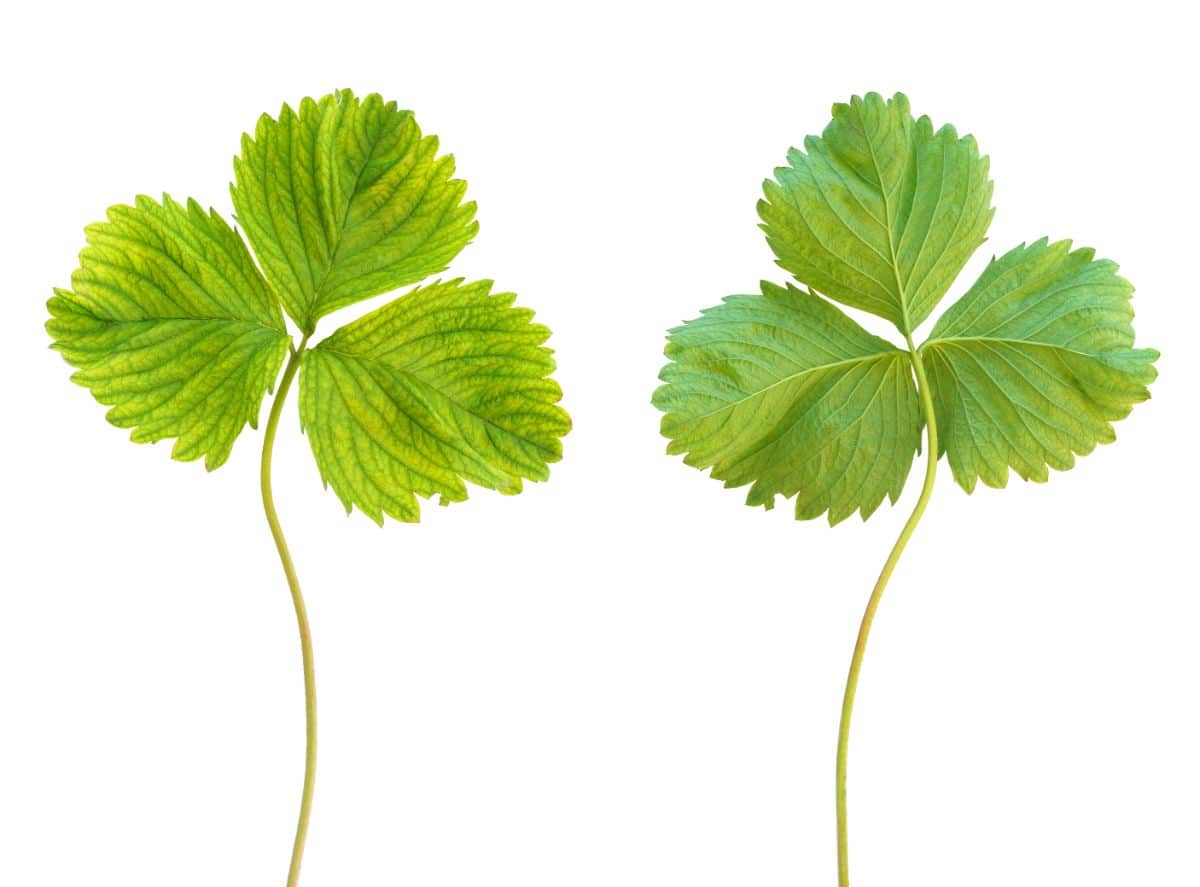
Yellow edges, green centers, no browning
This pattern of yellowing on young leaves may be the result of magnesium or manganese deficiency.
Small and yellow
Small yellowish leaves indicate a possible nitrogen deficiency. Use a soil test kit to make sure and address any other nutrient needs at the same time. Some leaves may also begin to turn purple.
Translucent lesions that appear yellow when held up to the light
This speckling is caused by angular leaf spot caused by the bacteria Xanthomonas fragariae. The bacteria hiding in your plant’s vascular system oozed out of lesions on the back of the leaves and may have now dried into a white powder. It spreads in wet or humid conditions and enters wounds or natural openings on nearby plants.
If you notice an infected plant at this stage, separate it from healthy plants in dry conditions. You can try treating the plant with an antibiotic called validamycin. For home growers, the best solution is to remove the plant at the end of the season and let the bacteria left in the soil die over winter. Angular leaf spot alone doesn’t have too much impact on berry production.
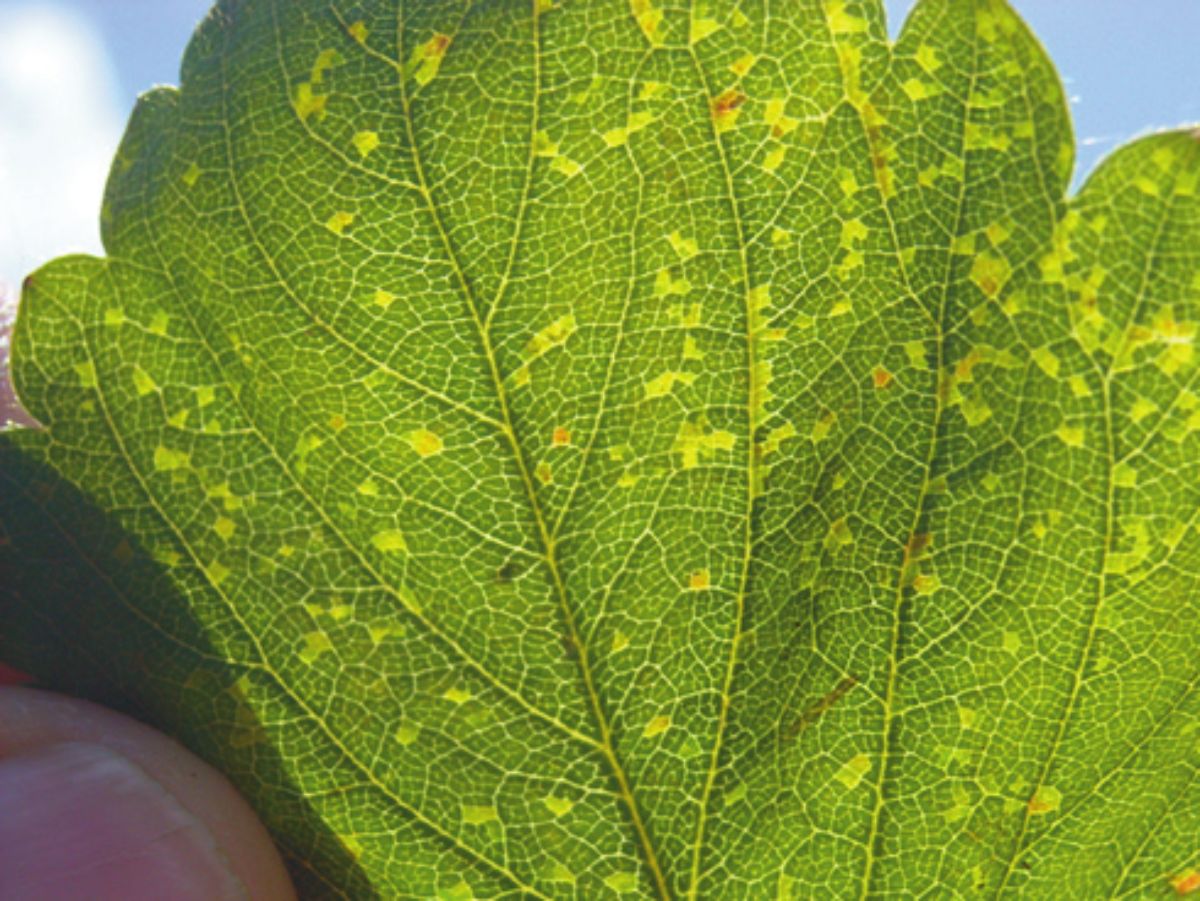
Photo by Michael A. Ellis as found on Ohioline.edu
Purple or Black
Irregular purple-black splotches on top of leaves
These splotches are older lesions caused by the angular leaf spot bacteria Xanthomonas fragariae. At this stage, it can resemble leaf scorch but that disease is caused by a fungus.
If you notice an infected plant at this stage, separate it from healthy plants in dry conditions. You can try treating the plant with an antibiotic called validamycin. For home growers, the best solution is to remove the plant at the end of the season and let the bacteria left in the soil die over winter. Angular leaf spot alone doesn’t have too much impact on berry production.
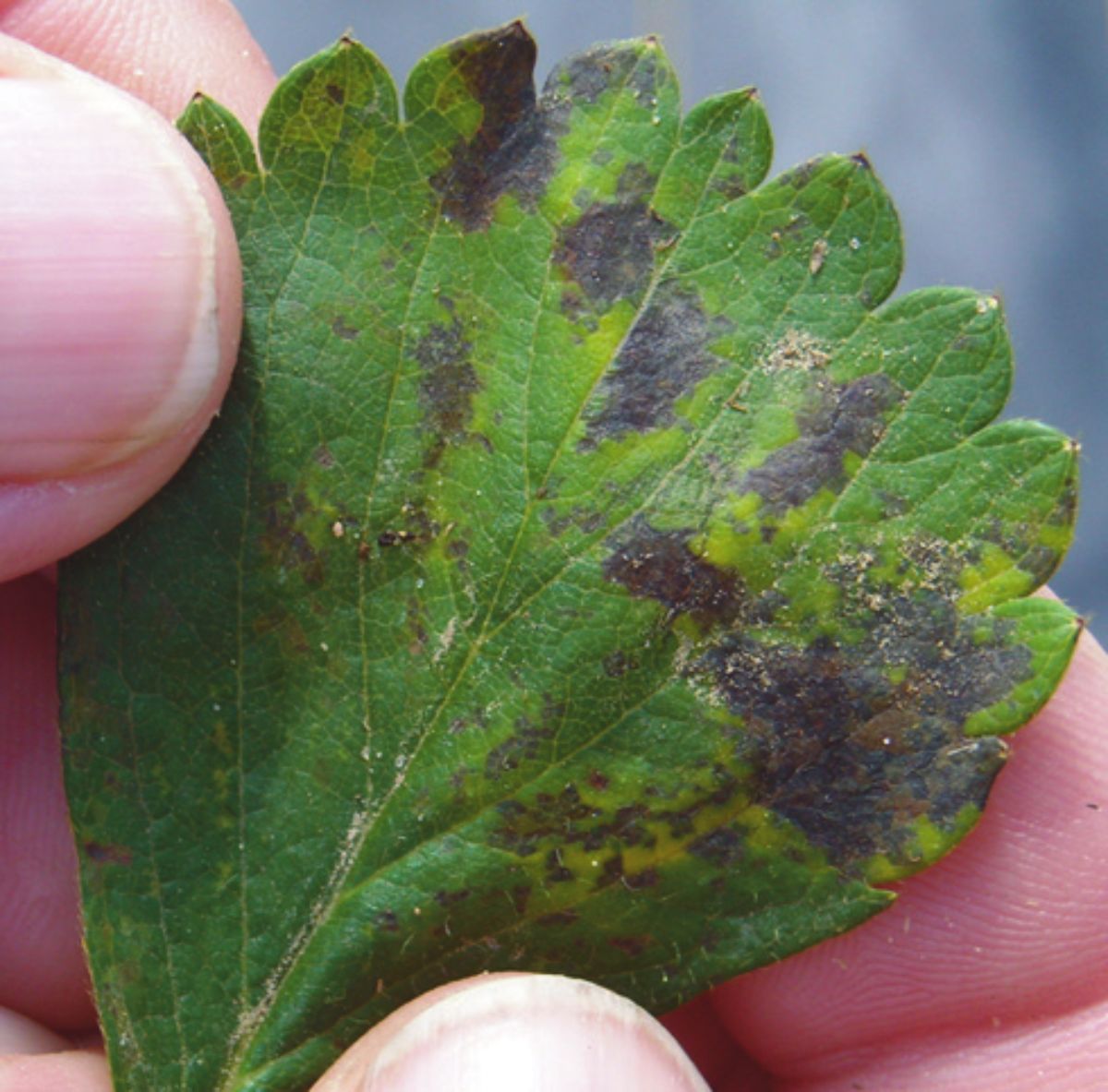
Photo by Michael A. Ellis as found on Ohioline.edu
Dark purple to reddish spots with light-colored centers
Dark purple to reddish spots with white, tan, or gray centers on young tender leaves are a sign of strawberry leaf spot.
Solid dark purple spots
Leaves that have small, solid dark purple spots without light-colored centers are in the early stages of a leaf scorch infection. If left to spread, the leaves will turn red-orange and eventually develop brown scorched edges.
This is a fungal disease. Remove the affected leaves and increase airflow between plants.
Purple leaves in addition to yellow leaves
This combination indicates a possible nitrogen deficiency. Use a soil test kit to make sure nitrogen is the only missing nutrient and address any other nutrient needs at the same time.
Brown or Tan
Brown Leaf Tips
Burned leaf tips may indicate a boron deficiency. Try foliar feeding but be careful not over-apply to prevent boron toxicity.
Brown Edges
Brown edges that look like a fringe may be the result of a calcium deficiency.
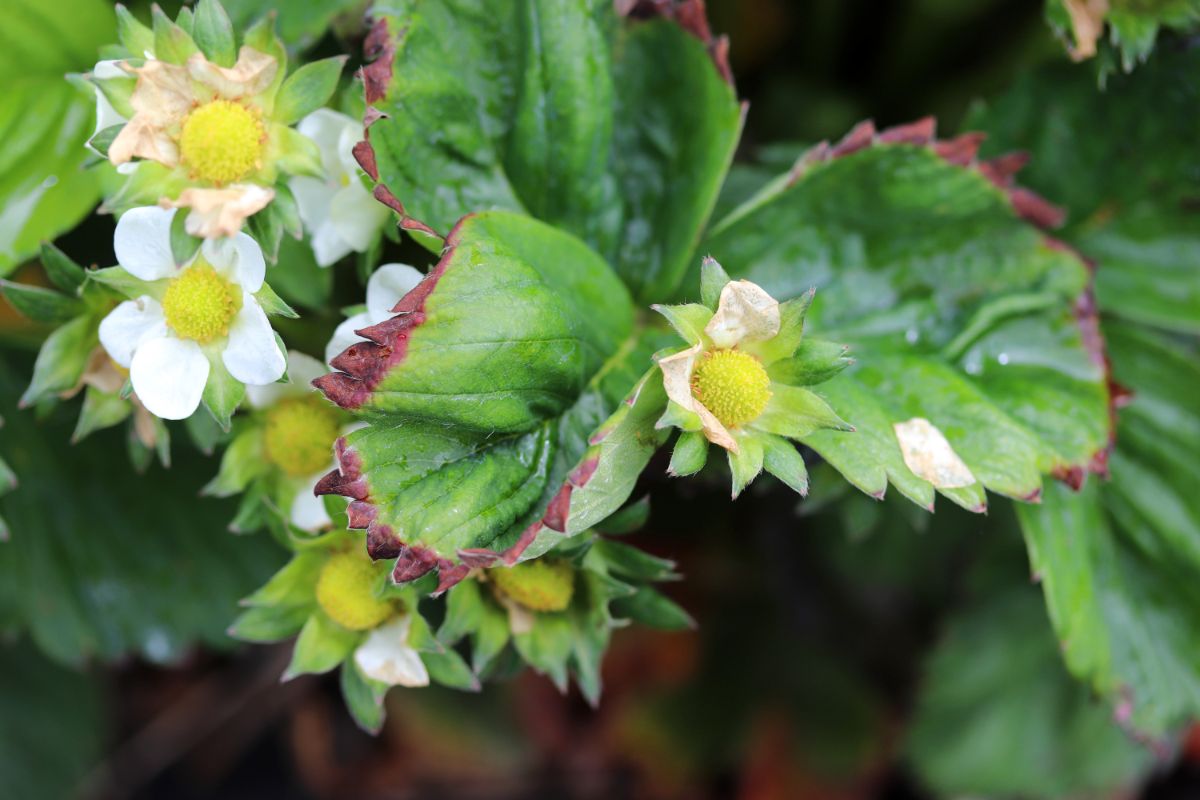
Brown edges with red field and purple spots
This is advanced leaf scorch. Remove affected leaves if possible to increase airflow. Clean up the strawberry bed at the end of the growing season since the fungus can overwinter on fallen leaves. Start new plants to replace severely infected older plants next year.
Gray to tan blotches
Gray to tan blotches on older leaves show your strawberry plants have leaf blotch. The fruit produced by plants with leaf blotch will be edible but ugly. There is no treatment for leaf blotch but you can prevent it by planting through plastic sheeting. The barrier prevents the fungus in the soil from splashing up onto the above-ground portions of the plant where it causes cosmetic damage.


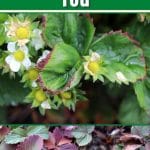
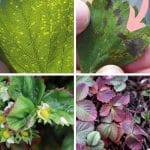
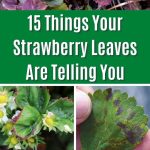
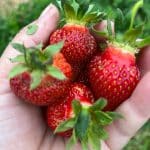



Ruan says
Hi, hope you all are doing well. My strawberry leaves are turning black, they aren’t dying though. I am kind of afraid the plant will die because of it. Its not just black spots, the entire leave is turning black, just the top sides. Does anyone know what it could be? And how to fix it? Please and thank you.
Laura says
I have the same – did you ever find out what it was?
Alex says
Hi, greetings from sunny Cape Town, South Africa. I noticed that the leaves on some of my Strawberry plants are feels thicker than the others and are very course. Any advise on the reason for this and how to remedy/cure will be highly appreciated please. Thank you for the great site and advise and input from all the Strawberry experts posting here. Regards.
John says
Hi, my Strawberry leave turned a really dark green after 4/5 intense midsummer days in the sun. I have another plant in a container next to it were the leaves are just normal green but the plant that has turned a dark green gets more full on sun in a South facing position. They have just started to flower too. is an intense Dark Green almost leathery appearance OK?
Mary Ward says
Yes this is okay. It may also be that they are darker green because they are in better soil.
Cecilie says
Hi! Just bought my first strawberry plant but i have noticed that some of the stems seems to be chewed trough. Like they are breaking. Is this something attacking the plant? Should I remove the affected stems?
Mary Ward says
Very hard to say without seeing the roots. It sounds like maybe they were dry? Were they potted or bare root plants?
Thomas B Allen says
hello. I transplanted strawberry bushes about a week ago and watered them. Now some of them look like they have a light brown spots on the leaves and one spot even had a hole quickly show itself on one of the bigger leaves. Some of the edges have this browning as well. What is this and how can I reverse it?
Mary Ward says
Hard to say without pictures but from your description, it sounds like they were too dry at some point. They’ll need frequent watering while they get established. The damage may have been done before they were planted, too. As long as they are growing and replacing the damage, they should be fine.
Marilyn Orders says
My strawberry leaves are growing white but there is no fungus on them they are healthy and flowering apart from the colour, are they deficient in something, I have them in a mix of 1/2 home compost and a good vegetable soil .
nicky holmes says
hi what causes blackish brown edges around the leaves of strawberries some of which have a brown v shaped patch from outside edge of leaves to the centre of the leaves. Thank you. It is mid spring here and the strawberry plants were recently transplanted to a different container.
Mary Ward says
It sounds like they got too dry. Plants usually need extra watering when transplanting and getting established. They should recover with adequate watering.
Eric says
How about healthy looking green leaves with just a tinge of white on the tips of the edges of some of the leaves?
Mary Ward says
You may have powdery mildew. Check the underside of the leaves–it starts there and then spreads to the top but when it makes the leap to the top side of the leaves it can give them a white edged appearance. Neem oil would be a good product to use (organic) but you need to spray the underside of the leaves, too.
Wendy says
I put my plants in new soil this year and they died for the most part. The soil is a 50/50 mix of top soil and composted dairy manure.
I tested the soil and found it was deficient on n potassium so I added bone meal.
The soil is heavy and WET so I dug the plants up and mixed in peat moss.
Nothing is helping.
The plants continue to act as if they’re drowning. Limp, brown leaves and eventually the plant dies.
I need help!
Mary Ward says
It sounds like your soil is soaking and holding too much water. Instead of peat, I would mix in sand.
Roz says
My strawberry leaves are sticky and lacey
Mary Ward says
That sounds like a bug issue. Inspect them for insects.
Stu says
What about blue leaves???
Elisha Doyle says
Thanks for sharing your tips. Your advice will come in handy 😁😁